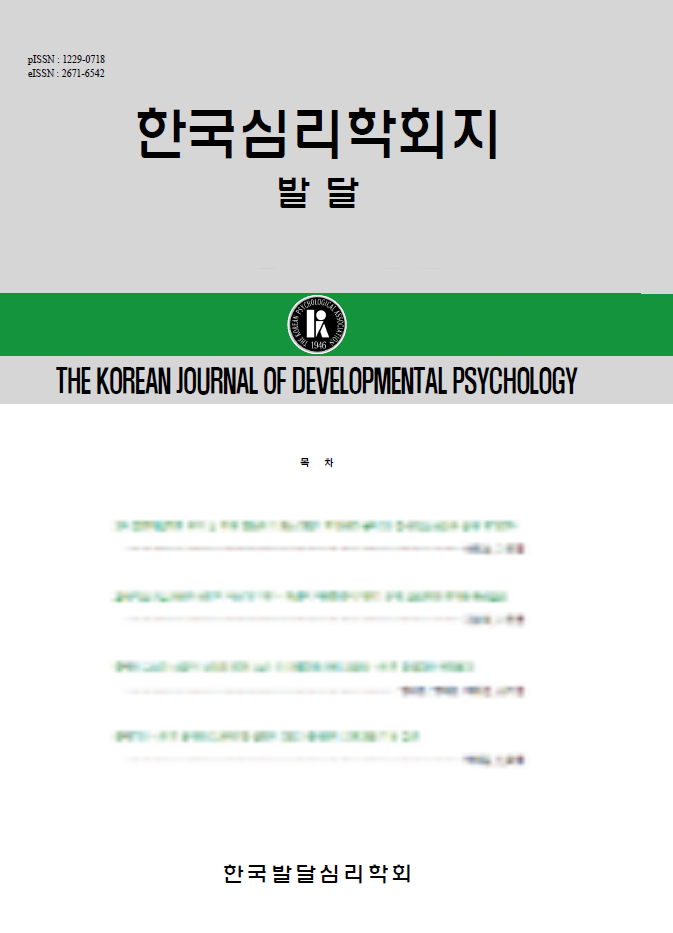open access
메뉴
open access
메뉴 ISSN : 1229-0718
ISSN : 1229-0718

The present studies examined the effects of domain-specific knowledge about physical object, anomals and facial expressions on the appearance-reality distinction. Experiment 1 assessed the ability of 3-, 5-, 7-, 9-year olds to distinguish between the real and apparent identities of illusory stimuli. Three domains of stimuli were used: physical objects, animals and facial expressions. Three- and 5-year-olds could not distinguish the real and apparent identities of illusory stimuli. The distinctions of the real and apparent identities of the animals and facial expressions were more diffcult than those of the physical object; even 7-year-olds cuold not distinguish the real and apparent facial expression. In Experment 2, children were presented with stories about the transformations of apparences performed upon the physical objects, animals and facial epressions of emotional states, and then were asked to distinguish the real versus apparent identities of them. Three- and 5-year-olds did not understand that the transformations of appearance did not change the real identities of animals and emotional states, and thus could not distinguish the real and apparent identities. In contrast, 7- and 9-year-olds distinguished and identified the real and apparent identities of three domains of stimuli. The present results suggests that the development of the appearance-reality distinctions is a domain specific development, which occurs at different times for different domains.
김영숙 ; 이현진 ; 김경아, (2005) 일상생활의 대화에서 나타난 한국 아동의 인과적 설명: 물리, 생물, 심리지식을 중심으로 ,
김혜리, (2000) 어린 아동의 실제정서와 표면정서의 이해: 아동의 마음이론 , 한국심리학회지: 발달
박선미 ; 정명숙 ; 김경아 ; 김영숙 ; 이현진 ; 김혜리 ; 양혜영 ; 변은희, (2005) 한국 아동의 물리, 심리, 생물지식의 발달(Ⅰ). 인지발달은 영역특정적인가? , 한국심리학회지: 일반
이동화 , (1990) 학령전 아동의 외양-실재 구분에 대한 이해 , 한국심리학회지: 발달,
Banerjee, M, (1997) Hidden emotions: preschoolers' knowledge of appearance-reality and emotion display rules , Social Cognition
Carey, S, (1994) Domain-specific knowledge and conceptual change; Mapping the mind: Domain specificity in cognition and culture , Cambridge, England: Cambridge University Press
Flavell, J. H, (1982) On cognitive development, Child Development
Flavell, J. H. , (1986) The development of children's knowledge about the appearance-reality distinction , American Psychologist
Flavell, J. H, (1988) The development of children's knowledge about the mind: From cognitive connections to mental representations; Developing theories of mind, New York: cambridge University Press
Flavell, J. H, (1983) Development of the appearance-reality distinction, Cognitive Psychology
Flavell, J. H, (1986) Development of knowledge about the appearance-reality distinction; Monographs of the Society for Research in Child Development, 51 (1, Serial No. 212) ,
Flavell, J. H, (1987) The effects of question clarification and memory aids on young children's performance on appearance-reality tasks, Cognitive Development
Gardner, D, (1988) Japanese children's understanding of the distinction between real and apparent emotion , International Journal of Behavioral Development
Gelman, R, (1998) Enabling constraints on cognitive development and learning: Domain specificity and epigenesis; Handbook of child psychology: vol. 2. Cognition, perception, and language, 5th , New York: Johns Wiley & Sons
Harris, P. L, (1986) Childrens understanding of the distinction between real and apparent emotion, Child Development
Hirschfeld, L. , (1994) Toward a topography of mind: An introduction to domain specificity in cognition and culture; Mapping the mind: Domain specificity in cognition and culture , New York; Cambridge University Press
Joshi, M. S, (1994) Indian and english children's understanding of the distinction between real and apparent emotion, Child Development
Keil, F. C. , (1986) Acquisition of natural kind and artifact terms ; Language learning and concept acquisition, Norwood, NJ: Ablex
Keil, F. C. , (1989) Concepts, kinds, and cognitive development, Cambridge, MA, The MIT Press
Perner, J. , (1991) Understanding the representational mind, Cambridge, MA: MIT Press
Piaget, J, (1929) The child's conception of the world , London: Routledge & Kegan Paul
Poulin-Dubois, D, (2001) Infants' attribution of causal roles to animate and inanimate objects, Poster presented at the meeting of the Society for Research in Child Development,
Spelke, E, (1991) Physical knowledge in infancy ; The epigenesis of mind , New Jersey: Lawrence Erlbaum
Spelke, E, (2000) Core knowledge, American Psychologist
Wellman, H, (1998) Handbook of child psychology: vol. 2. Cognition, perception, and language, 5th , New York: Johns Wiley & Sons
Gopnik, A, (1988) Childrens understanding of representational change and its relation to the understanding of false belief and the appearance-reality distinction, Child Development
Wellman, H, (1997) The emergence of core domains of though: The children's reasoning about physical, psychological, and biological phenomena Woolley, J., & Wellman, H. M. (1990). Young children's understanding of realities, nonrealities, and appearances. Child Development, 61, 946-961. , Jossey-Bass Publishers.
Woodward, A. , (1998) Infants selectively encode the goals of a human actor, Cognition
Woolley, J, (1990) Young children's understanding of realities, nonrealities, and appearances , Child Development
